Issues in Contemporary Accounting
VerifiedAdded on 2022/11/19
|11
|2709
|150
AI Summary
This report aims to research and understand the revolutionary theories of Thomas Kuhn in the area of shifts in paradigm and his explanation of the structure of what constitutes a scientific revolution. The learnings from this research are then applied in understanding the contributions made by Professor Ray Chambers towards the field of accountancy.
Contribute Materials
Your contribution can guide someone’s learning journey. Share your
documents today.
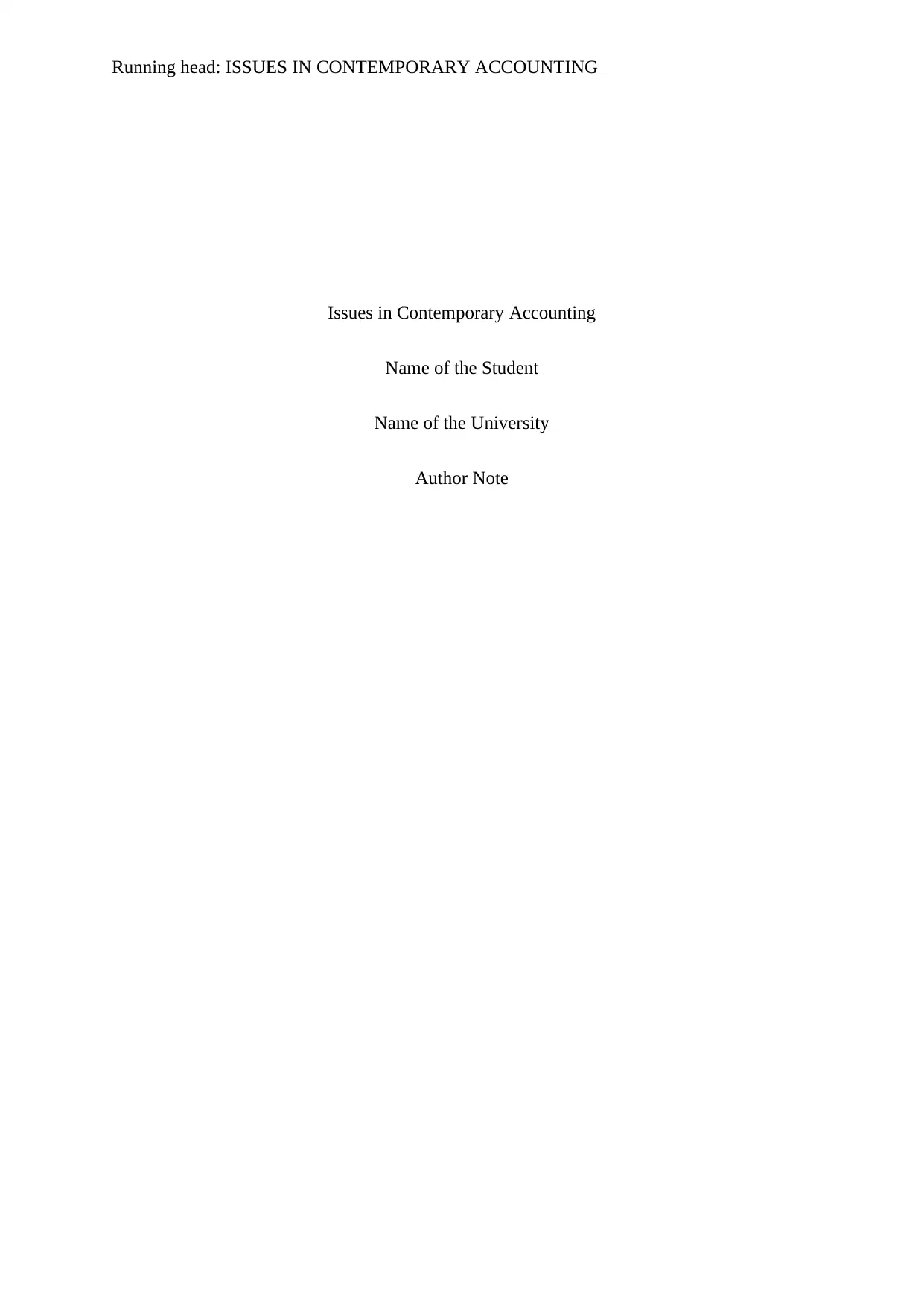
Running head: ISSUES IN CONTEMPORARY ACCOUNTING
Issues in Contemporary Accounting
Name of the Student
Name of the University
Author Note
Issues in Contemporary Accounting
Name of the Student
Name of the University
Author Note
Secure Best Marks with AI Grader
Need help grading? Try our AI Grader for instant feedback on your assignments.
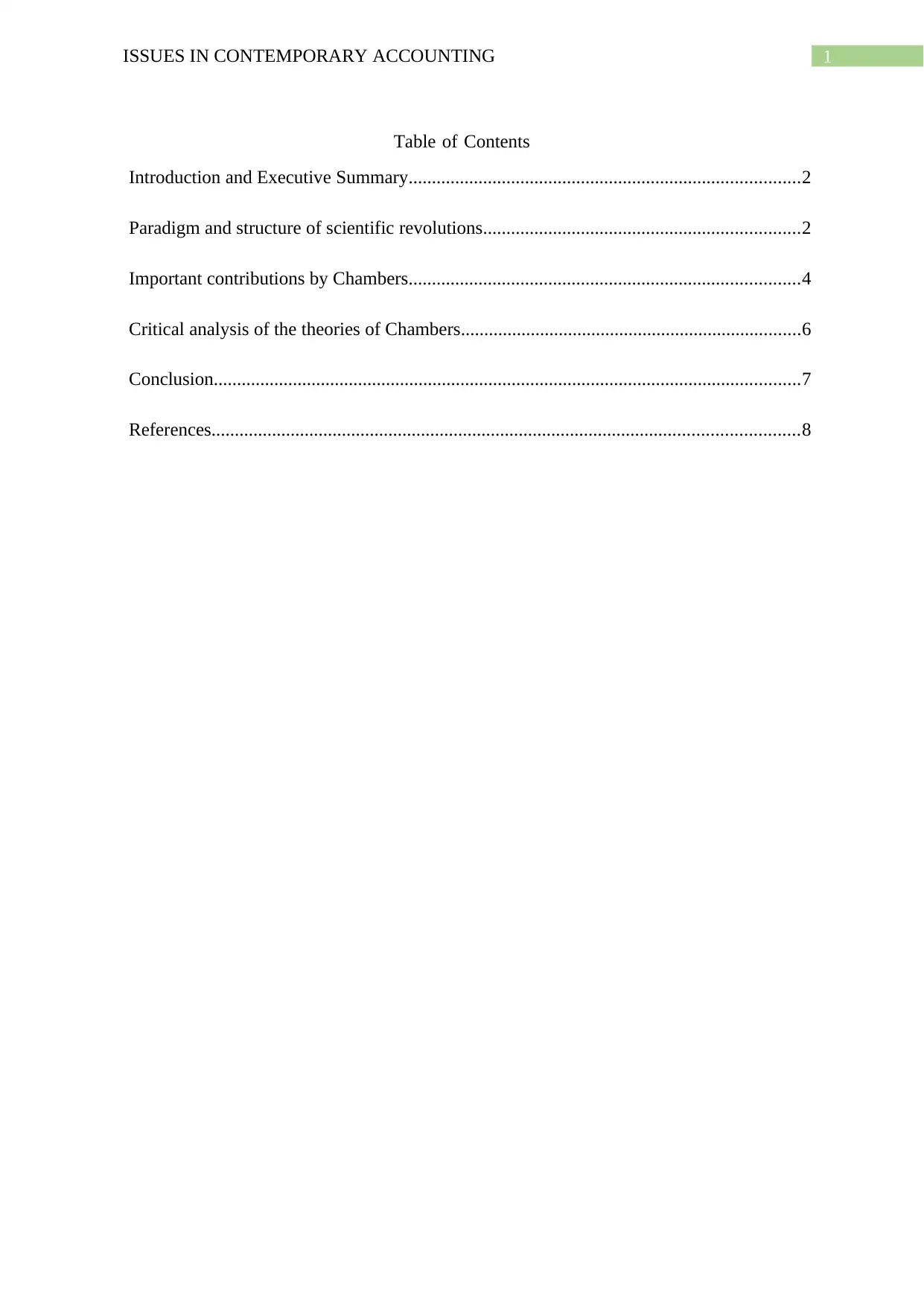
1ISSUES IN CONTEMPORARY ACCOUNTING
Table of Contents
Introduction and Executive Summary....................................................................................2
Paradigm and structure of scientific revolutions....................................................................2
Important contributions by Chambers....................................................................................4
Critical analysis of the theories of Chambers.........................................................................6
Conclusion..............................................................................................................................7
References..............................................................................................................................8
Table of Contents
Introduction and Executive Summary....................................................................................2
Paradigm and structure of scientific revolutions....................................................................2
Important contributions by Chambers....................................................................................4
Critical analysis of the theories of Chambers.........................................................................6
Conclusion..............................................................................................................................7
References..............................................................................................................................8
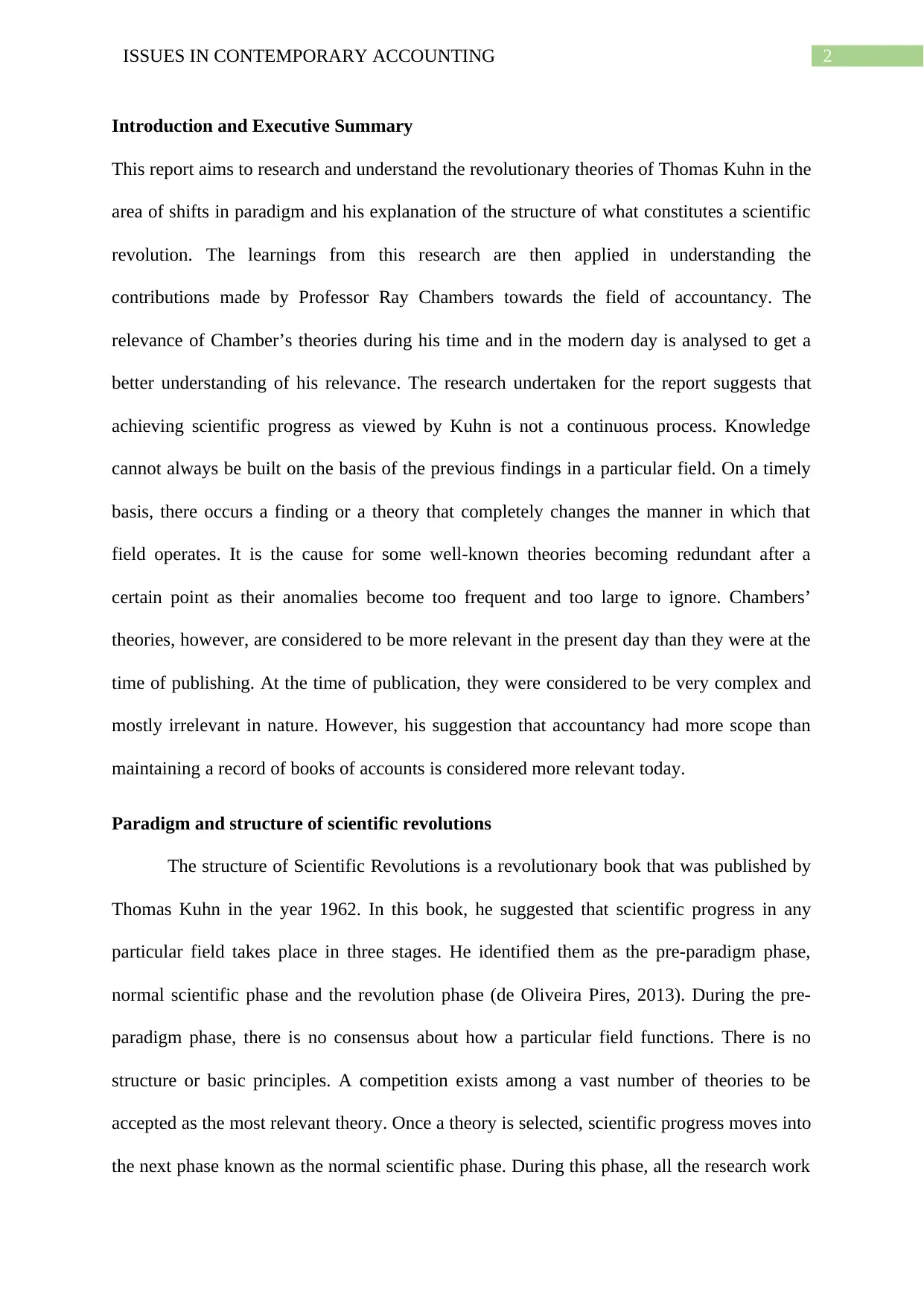
2ISSUES IN CONTEMPORARY ACCOUNTING
Introduction and Executive Summary
This report aims to research and understand the revolutionary theories of Thomas Kuhn in the
area of shifts in paradigm and his explanation of the structure of what constitutes a scientific
revolution. The learnings from this research are then applied in understanding the
contributions made by Professor Ray Chambers towards the field of accountancy. The
relevance of Chamber’s theories during his time and in the modern day is analysed to get a
better understanding of his relevance. The research undertaken for the report suggests that
achieving scientific progress as viewed by Kuhn is not a continuous process. Knowledge
cannot always be built on the basis of the previous findings in a particular field. On a timely
basis, there occurs a finding or a theory that completely changes the manner in which that
field operates. It is the cause for some well-known theories becoming redundant after a
certain point as their anomalies become too frequent and too large to ignore. Chambers’
theories, however, are considered to be more relevant in the present day than they were at the
time of publishing. At the time of publication, they were considered to be very complex and
mostly irrelevant in nature. However, his suggestion that accountancy had more scope than
maintaining a record of books of accounts is considered more relevant today.
Paradigm and structure of scientific revolutions
The structure of Scientific Revolutions is a revolutionary book that was published by
Thomas Kuhn in the year 1962. In this book, he suggested that scientific progress in any
particular field takes place in three stages. He identified them as the pre-paradigm phase,
normal scientific phase and the revolution phase (de Oliveira Pires, 2013). During the pre-
paradigm phase, there is no consensus about how a particular field functions. There is no
structure or basic principles. A competition exists among a vast number of theories to be
accepted as the most relevant theory. Once a theory is selected, scientific progress moves into
the next phase known as the normal scientific phase. During this phase, all the research work
Introduction and Executive Summary
This report aims to research and understand the revolutionary theories of Thomas Kuhn in the
area of shifts in paradigm and his explanation of the structure of what constitutes a scientific
revolution. The learnings from this research are then applied in understanding the
contributions made by Professor Ray Chambers towards the field of accountancy. The
relevance of Chamber’s theories during his time and in the modern day is analysed to get a
better understanding of his relevance. The research undertaken for the report suggests that
achieving scientific progress as viewed by Kuhn is not a continuous process. Knowledge
cannot always be built on the basis of the previous findings in a particular field. On a timely
basis, there occurs a finding or a theory that completely changes the manner in which that
field operates. It is the cause for some well-known theories becoming redundant after a
certain point as their anomalies become too frequent and too large to ignore. Chambers’
theories, however, are considered to be more relevant in the present day than they were at the
time of publishing. At the time of publication, they were considered to be very complex and
mostly irrelevant in nature. However, his suggestion that accountancy had more scope than
maintaining a record of books of accounts is considered more relevant today.
Paradigm and structure of scientific revolutions
The structure of Scientific Revolutions is a revolutionary book that was published by
Thomas Kuhn in the year 1962. In this book, he suggested that scientific progress in any
particular field takes place in three stages. He identified them as the pre-paradigm phase,
normal scientific phase and the revolution phase (de Oliveira Pires, 2013). During the pre-
paradigm phase, there is no consensus about how a particular field functions. There is no
structure or basic principles. A competition exists among a vast number of theories to be
accepted as the most relevant theory. Once a theory is selected, scientific progress moves into
the next phase known as the normal scientific phase. During this phase, all the research work
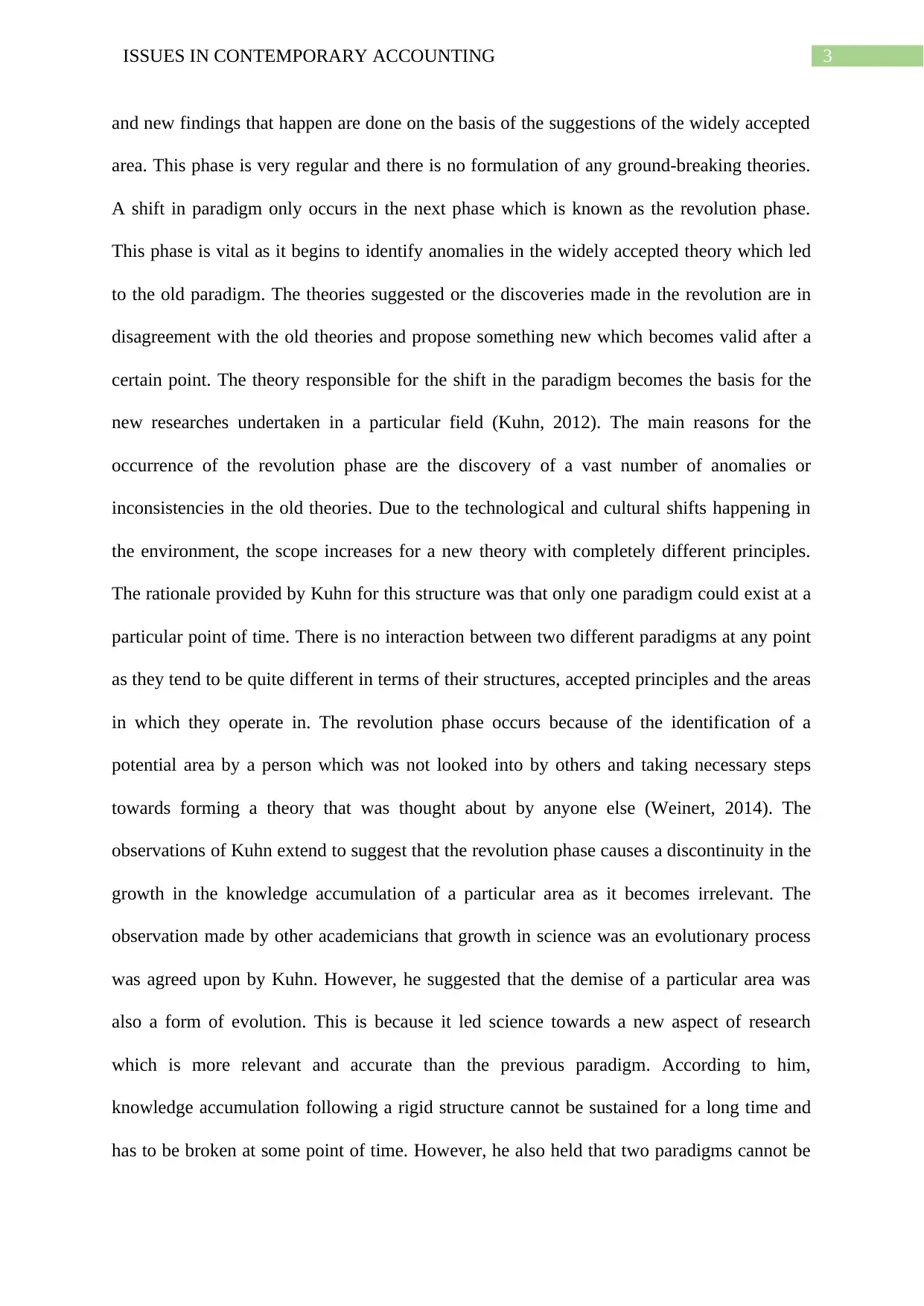
3ISSUES IN CONTEMPORARY ACCOUNTING
and new findings that happen are done on the basis of the suggestions of the widely accepted
area. This phase is very regular and there is no formulation of any ground-breaking theories.
A shift in paradigm only occurs in the next phase which is known as the revolution phase.
This phase is vital as it begins to identify anomalies in the widely accepted theory which led
to the old paradigm. The theories suggested or the discoveries made in the revolution are in
disagreement with the old theories and propose something new which becomes valid after a
certain point. The theory responsible for the shift in the paradigm becomes the basis for the
new researches undertaken in a particular field (Kuhn, 2012). The main reasons for the
occurrence of the revolution phase are the discovery of a vast number of anomalies or
inconsistencies in the old theories. Due to the technological and cultural shifts happening in
the environment, the scope increases for a new theory with completely different principles.
The rationale provided by Kuhn for this structure was that only one paradigm could exist at a
particular point of time. There is no interaction between two different paradigms at any point
as they tend to be quite different in terms of their structures, accepted principles and the areas
in which they operate in. The revolution phase occurs because of the identification of a
potential area by a person which was not looked into by others and taking necessary steps
towards forming a theory that was thought about by anyone else (Weinert, 2014). The
observations of Kuhn extend to suggest that the revolution phase causes a discontinuity in the
growth in the knowledge accumulation of a particular area as it becomes irrelevant. The
observation made by other academicians that growth in science was an evolutionary process
was agreed upon by Kuhn. However, he suggested that the demise of a particular area was
also a form of evolution. This is because it led science towards a new aspect of research
which is more relevant and accurate than the previous paradigm. According to him,
knowledge accumulation following a rigid structure cannot be sustained for a long time and
has to be broken at some point of time. However, he also held that two paradigms cannot be
and new findings that happen are done on the basis of the suggestions of the widely accepted
area. This phase is very regular and there is no formulation of any ground-breaking theories.
A shift in paradigm only occurs in the next phase which is known as the revolution phase.
This phase is vital as it begins to identify anomalies in the widely accepted theory which led
to the old paradigm. The theories suggested or the discoveries made in the revolution are in
disagreement with the old theories and propose something new which becomes valid after a
certain point. The theory responsible for the shift in the paradigm becomes the basis for the
new researches undertaken in a particular field (Kuhn, 2012). The main reasons for the
occurrence of the revolution phase are the discovery of a vast number of anomalies or
inconsistencies in the old theories. Due to the technological and cultural shifts happening in
the environment, the scope increases for a new theory with completely different principles.
The rationale provided by Kuhn for this structure was that only one paradigm could exist at a
particular point of time. There is no interaction between two different paradigms at any point
as they tend to be quite different in terms of their structures, accepted principles and the areas
in which they operate in. The revolution phase occurs because of the identification of a
potential area by a person which was not looked into by others and taking necessary steps
towards forming a theory that was thought about by anyone else (Weinert, 2014). The
observations of Kuhn extend to suggest that the revolution phase causes a discontinuity in the
growth in the knowledge accumulation of a particular area as it becomes irrelevant. The
observation made by other academicians that growth in science was an evolutionary process
was agreed upon by Kuhn. However, he suggested that the demise of a particular area was
also a form of evolution. This is because it led science towards a new aspect of research
which is more relevant and accurate than the previous paradigm. According to him,
knowledge accumulation following a rigid structure cannot be sustained for a long time and
has to be broken at some point of time. However, he also held that two paradigms cannot be
Secure Best Marks with AI Grader
Need help grading? Try our AI Grader for instant feedback on your assignments.
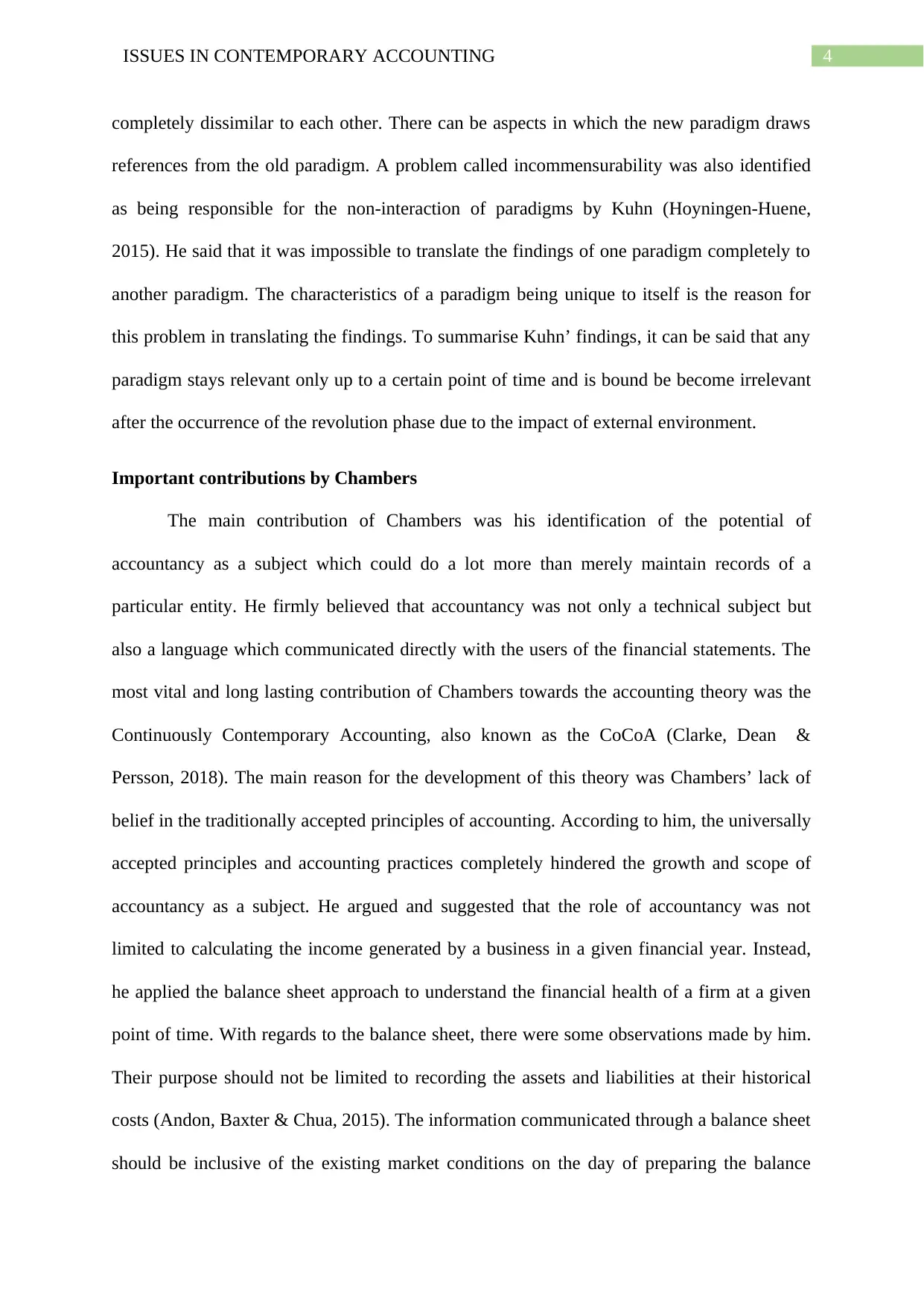
4ISSUES IN CONTEMPORARY ACCOUNTING
completely dissimilar to each other. There can be aspects in which the new paradigm draws
references from the old paradigm. A problem called incommensurability was also identified
as being responsible for the non-interaction of paradigms by Kuhn (Hoyningen-Huene,
2015). He said that it was impossible to translate the findings of one paradigm completely to
another paradigm. The characteristics of a paradigm being unique to itself is the reason for
this problem in translating the findings. To summarise Kuhn’ findings, it can be said that any
paradigm stays relevant only up to a certain point of time and is bound be become irrelevant
after the occurrence of the revolution phase due to the impact of external environment.
Important contributions by Chambers
The main contribution of Chambers was his identification of the potential of
accountancy as a subject which could do a lot more than merely maintain records of a
particular entity. He firmly believed that accountancy was not only a technical subject but
also a language which communicated directly with the users of the financial statements. The
most vital and long lasting contribution of Chambers towards the accounting theory was the
Continuously Contemporary Accounting, also known as the CoCoA (Clarke, Dean &
Persson, 2018). The main reason for the development of this theory was Chambers’ lack of
belief in the traditionally accepted principles of accounting. According to him, the universally
accepted principles and accounting practices completely hindered the growth and scope of
accountancy as a subject. He argued and suggested that the role of accountancy was not
limited to calculating the income generated by a business in a given financial year. Instead,
he applied the balance sheet approach to understand the financial health of a firm at a given
point of time. With regards to the balance sheet, there were some observations made by him.
Their purpose should not be limited to recording the assets and liabilities at their historical
costs (Andon, Baxter & Chua, 2015). The information communicated through a balance sheet
should be inclusive of the existing market conditions on the day of preparing the balance
completely dissimilar to each other. There can be aspects in which the new paradigm draws
references from the old paradigm. A problem called incommensurability was also identified
as being responsible for the non-interaction of paradigms by Kuhn (Hoyningen-Huene,
2015). He said that it was impossible to translate the findings of one paradigm completely to
another paradigm. The characteristics of a paradigm being unique to itself is the reason for
this problem in translating the findings. To summarise Kuhn’ findings, it can be said that any
paradigm stays relevant only up to a certain point of time and is bound be become irrelevant
after the occurrence of the revolution phase due to the impact of external environment.
Important contributions by Chambers
The main contribution of Chambers was his identification of the potential of
accountancy as a subject which could do a lot more than merely maintain records of a
particular entity. He firmly believed that accountancy was not only a technical subject but
also a language which communicated directly with the users of the financial statements. The
most vital and long lasting contribution of Chambers towards the accounting theory was the
Continuously Contemporary Accounting, also known as the CoCoA (Clarke, Dean &
Persson, 2018). The main reason for the development of this theory was Chambers’ lack of
belief in the traditionally accepted principles of accounting. According to him, the universally
accepted principles and accounting practices completely hindered the growth and scope of
accountancy as a subject. He argued and suggested that the role of accountancy was not
limited to calculating the income generated by a business in a given financial year. Instead,
he applied the balance sheet approach to understand the financial health of a firm at a given
point of time. With regards to the balance sheet, there were some observations made by him.
Their purpose should not be limited to recording the assets and liabilities at their historical
costs (Andon, Baxter & Chua, 2015). The information communicated through a balance sheet
should be inclusive of the existing market conditions on the day of preparing the balance
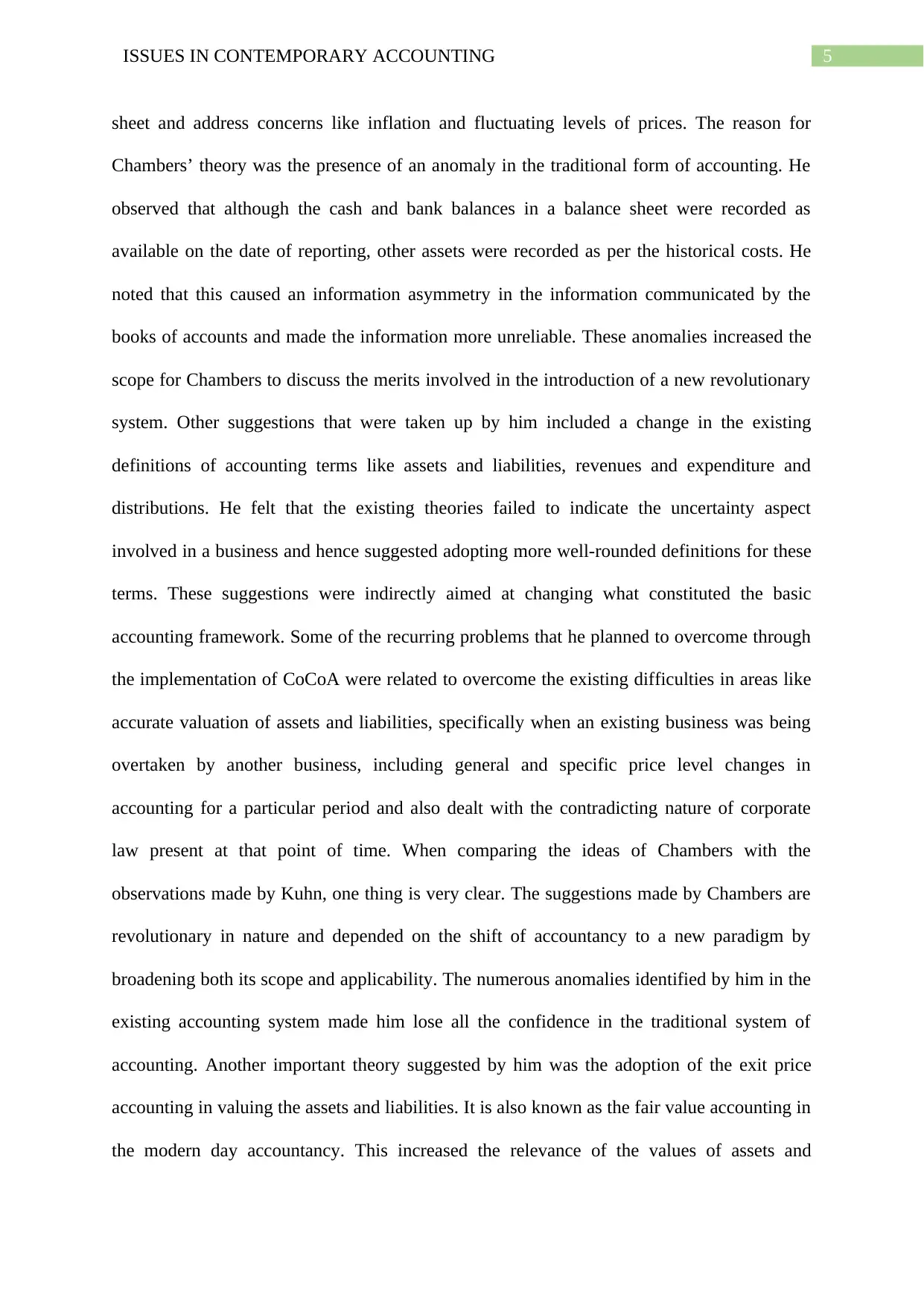
5ISSUES IN CONTEMPORARY ACCOUNTING
sheet and address concerns like inflation and fluctuating levels of prices. The reason for
Chambers’ theory was the presence of an anomaly in the traditional form of accounting. He
observed that although the cash and bank balances in a balance sheet were recorded as
available on the date of reporting, other assets were recorded as per the historical costs. He
noted that this caused an information asymmetry in the information communicated by the
books of accounts and made the information more unreliable. These anomalies increased the
scope for Chambers to discuss the merits involved in the introduction of a new revolutionary
system. Other suggestions that were taken up by him included a change in the existing
definitions of accounting terms like assets and liabilities, revenues and expenditure and
distributions. He felt that the existing theories failed to indicate the uncertainty aspect
involved in a business and hence suggested adopting more well-rounded definitions for these
terms. These suggestions were indirectly aimed at changing what constituted the basic
accounting framework. Some of the recurring problems that he planned to overcome through
the implementation of CoCoA were related to overcome the existing difficulties in areas like
accurate valuation of assets and liabilities, specifically when an existing business was being
overtaken by another business, including general and specific price level changes in
accounting for a particular period and also dealt with the contradicting nature of corporate
law present at that point of time. When comparing the ideas of Chambers with the
observations made by Kuhn, one thing is very clear. The suggestions made by Chambers are
revolutionary in nature and depended on the shift of accountancy to a new paradigm by
broadening both its scope and applicability. The numerous anomalies identified by him in the
existing accounting system made him lose all the confidence in the traditional system of
accounting. Another important theory suggested by him was the adoption of the exit price
accounting in valuing the assets and liabilities. It is also known as the fair value accounting in
the modern day accountancy. This increased the relevance of the values of assets and
sheet and address concerns like inflation and fluctuating levels of prices. The reason for
Chambers’ theory was the presence of an anomaly in the traditional form of accounting. He
observed that although the cash and bank balances in a balance sheet were recorded as
available on the date of reporting, other assets were recorded as per the historical costs. He
noted that this caused an information asymmetry in the information communicated by the
books of accounts and made the information more unreliable. These anomalies increased the
scope for Chambers to discuss the merits involved in the introduction of a new revolutionary
system. Other suggestions that were taken up by him included a change in the existing
definitions of accounting terms like assets and liabilities, revenues and expenditure and
distributions. He felt that the existing theories failed to indicate the uncertainty aspect
involved in a business and hence suggested adopting more well-rounded definitions for these
terms. These suggestions were indirectly aimed at changing what constituted the basic
accounting framework. Some of the recurring problems that he planned to overcome through
the implementation of CoCoA were related to overcome the existing difficulties in areas like
accurate valuation of assets and liabilities, specifically when an existing business was being
overtaken by another business, including general and specific price level changes in
accounting for a particular period and also dealt with the contradicting nature of corporate
law present at that point of time. When comparing the ideas of Chambers with the
observations made by Kuhn, one thing is very clear. The suggestions made by Chambers are
revolutionary in nature and depended on the shift of accountancy to a new paradigm by
broadening both its scope and applicability. The numerous anomalies identified by him in the
existing accounting system made him lose all the confidence in the traditional system of
accounting. Another important theory suggested by him was the adoption of the exit price
accounting in valuing the assets and liabilities. It is also known as the fair value accounting in
the modern day accountancy. This increased the relevance of the values of assets and
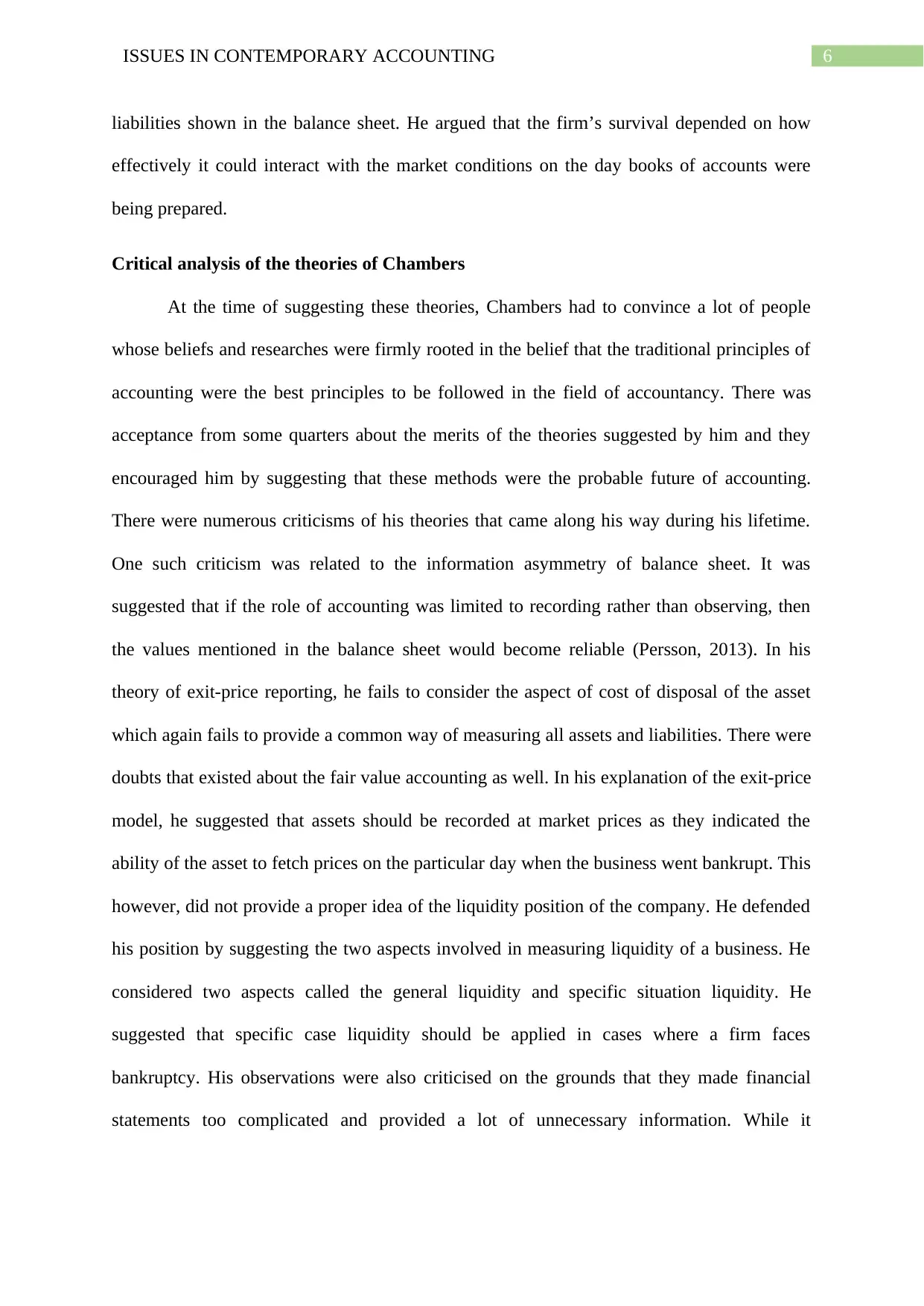
6ISSUES IN CONTEMPORARY ACCOUNTING
liabilities shown in the balance sheet. He argued that the firm’s survival depended on how
effectively it could interact with the market conditions on the day books of accounts were
being prepared.
Critical analysis of the theories of Chambers
At the time of suggesting these theories, Chambers had to convince a lot of people
whose beliefs and researches were firmly rooted in the belief that the traditional principles of
accounting were the best principles to be followed in the field of accountancy. There was
acceptance from some quarters about the merits of the theories suggested by him and they
encouraged him by suggesting that these methods were the probable future of accounting.
There were numerous criticisms of his theories that came along his way during his lifetime.
One such criticism was related to the information asymmetry of balance sheet. It was
suggested that if the role of accounting was limited to recording rather than observing, then
the values mentioned in the balance sheet would become reliable (Persson, 2013). In his
theory of exit-price reporting, he fails to consider the aspect of cost of disposal of the asset
which again fails to provide a common way of measuring all assets and liabilities. There were
doubts that existed about the fair value accounting as well. In his explanation of the exit-price
model, he suggested that assets should be recorded at market prices as they indicated the
ability of the asset to fetch prices on the particular day when the business went bankrupt. This
however, did not provide a proper idea of the liquidity position of the company. He defended
his position by suggesting the two aspects involved in measuring liquidity of a business. He
considered two aspects called the general liquidity and specific situation liquidity. He
suggested that specific case liquidity should be applied in cases where a firm faces
bankruptcy. His observations were also criticised on the grounds that they made financial
statements too complicated and provided a lot of unnecessary information. While it
liabilities shown in the balance sheet. He argued that the firm’s survival depended on how
effectively it could interact with the market conditions on the day books of accounts were
being prepared.
Critical analysis of the theories of Chambers
At the time of suggesting these theories, Chambers had to convince a lot of people
whose beliefs and researches were firmly rooted in the belief that the traditional principles of
accounting were the best principles to be followed in the field of accountancy. There was
acceptance from some quarters about the merits of the theories suggested by him and they
encouraged him by suggesting that these methods were the probable future of accounting.
There were numerous criticisms of his theories that came along his way during his lifetime.
One such criticism was related to the information asymmetry of balance sheet. It was
suggested that if the role of accounting was limited to recording rather than observing, then
the values mentioned in the balance sheet would become reliable (Persson, 2013). In his
theory of exit-price reporting, he fails to consider the aspect of cost of disposal of the asset
which again fails to provide a common way of measuring all assets and liabilities. There were
doubts that existed about the fair value accounting as well. In his explanation of the exit-price
model, he suggested that assets should be recorded at market prices as they indicated the
ability of the asset to fetch prices on the particular day when the business went bankrupt. This
however, did not provide a proper idea of the liquidity position of the company. He defended
his position by suggesting the two aspects involved in measuring liquidity of a business. He
considered two aspects called the general liquidity and specific situation liquidity. He
suggested that specific case liquidity should be applied in cases where a firm faces
bankruptcy. His observations were also criticised on the grounds that they made financial
statements too complicated and provided a lot of unnecessary information. While it
Paraphrase This Document
Need a fresh take? Get an instant paraphrase of this document with our AI Paraphraser
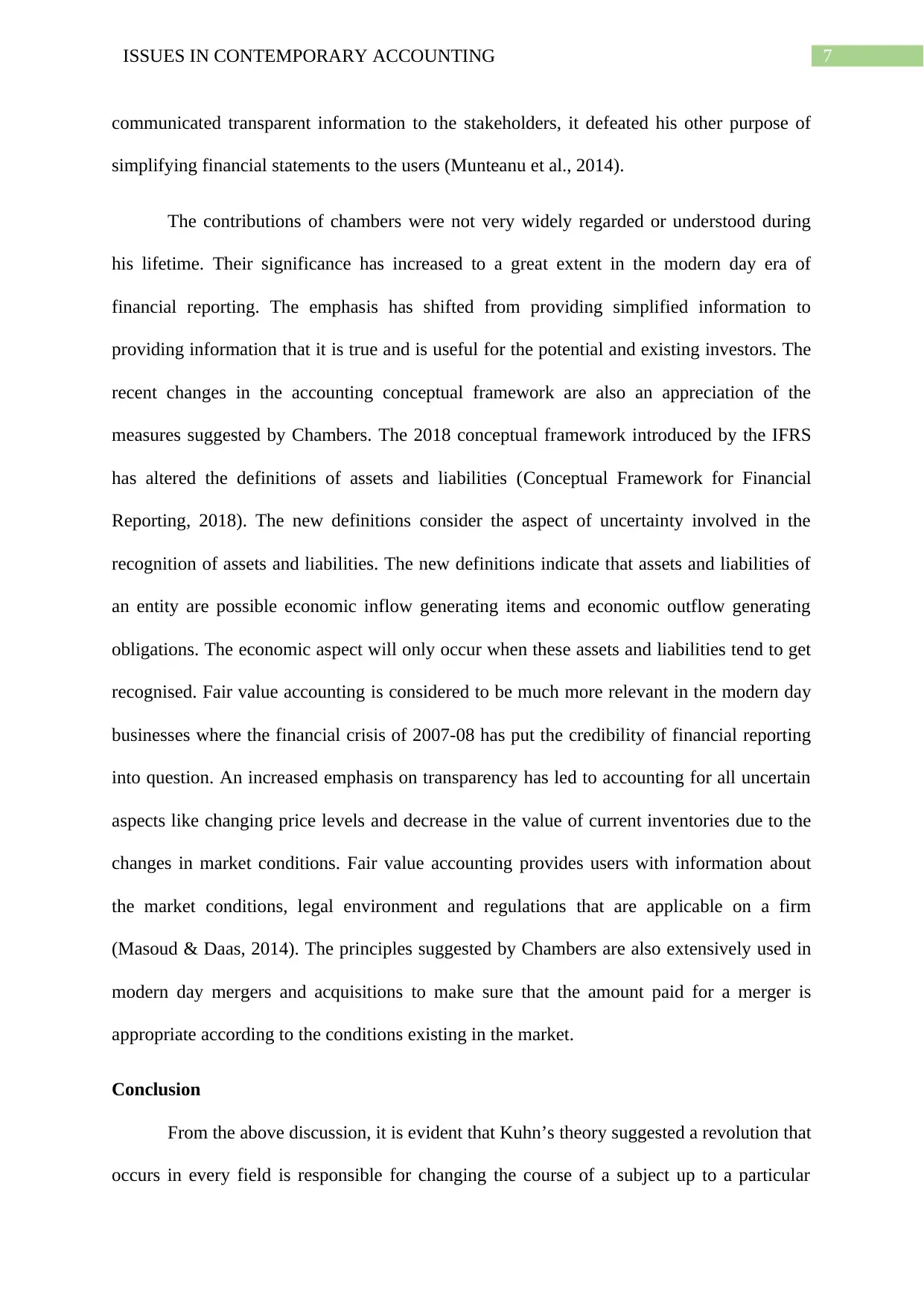
7ISSUES IN CONTEMPORARY ACCOUNTING
communicated transparent information to the stakeholders, it defeated his other purpose of
simplifying financial statements to the users (Munteanu et al., 2014).
The contributions of chambers were not very widely regarded or understood during
his lifetime. Their significance has increased to a great extent in the modern day era of
financial reporting. The emphasis has shifted from providing simplified information to
providing information that it is true and is useful for the potential and existing investors. The
recent changes in the accounting conceptual framework are also an appreciation of the
measures suggested by Chambers. The 2018 conceptual framework introduced by the IFRS
has altered the definitions of assets and liabilities (Conceptual Framework for Financial
Reporting, 2018). The new definitions consider the aspect of uncertainty involved in the
recognition of assets and liabilities. The new definitions indicate that assets and liabilities of
an entity are possible economic inflow generating items and economic outflow generating
obligations. The economic aspect will only occur when these assets and liabilities tend to get
recognised. Fair value accounting is considered to be much more relevant in the modern day
businesses where the financial crisis of 2007-08 has put the credibility of financial reporting
into question. An increased emphasis on transparency has led to accounting for all uncertain
aspects like changing price levels and decrease in the value of current inventories due to the
changes in market conditions. Fair value accounting provides users with information about
the market conditions, legal environment and regulations that are applicable on a firm
(Masoud & Daas, 2014). The principles suggested by Chambers are also extensively used in
modern day mergers and acquisitions to make sure that the amount paid for a merger is
appropriate according to the conditions existing in the market.
Conclusion
From the above discussion, it is evident that Kuhn’s theory suggested a revolution that
occurs in every field is responsible for changing the course of a subject up to a particular
communicated transparent information to the stakeholders, it defeated his other purpose of
simplifying financial statements to the users (Munteanu et al., 2014).
The contributions of chambers were not very widely regarded or understood during
his lifetime. Their significance has increased to a great extent in the modern day era of
financial reporting. The emphasis has shifted from providing simplified information to
providing information that it is true and is useful for the potential and existing investors. The
recent changes in the accounting conceptual framework are also an appreciation of the
measures suggested by Chambers. The 2018 conceptual framework introduced by the IFRS
has altered the definitions of assets and liabilities (Conceptual Framework for Financial
Reporting, 2018). The new definitions consider the aspect of uncertainty involved in the
recognition of assets and liabilities. The new definitions indicate that assets and liabilities of
an entity are possible economic inflow generating items and economic outflow generating
obligations. The economic aspect will only occur when these assets and liabilities tend to get
recognised. Fair value accounting is considered to be much more relevant in the modern day
businesses where the financial crisis of 2007-08 has put the credibility of financial reporting
into question. An increased emphasis on transparency has led to accounting for all uncertain
aspects like changing price levels and decrease in the value of current inventories due to the
changes in market conditions. Fair value accounting provides users with information about
the market conditions, legal environment and regulations that are applicable on a firm
(Masoud & Daas, 2014). The principles suggested by Chambers are also extensively used in
modern day mergers and acquisitions to make sure that the amount paid for a merger is
appropriate according to the conditions existing in the market.
Conclusion
From the above discussion, it is evident that Kuhn’s theory suggested a revolution that
occurs in every field is responsible for changing the course of a subject up to a particular
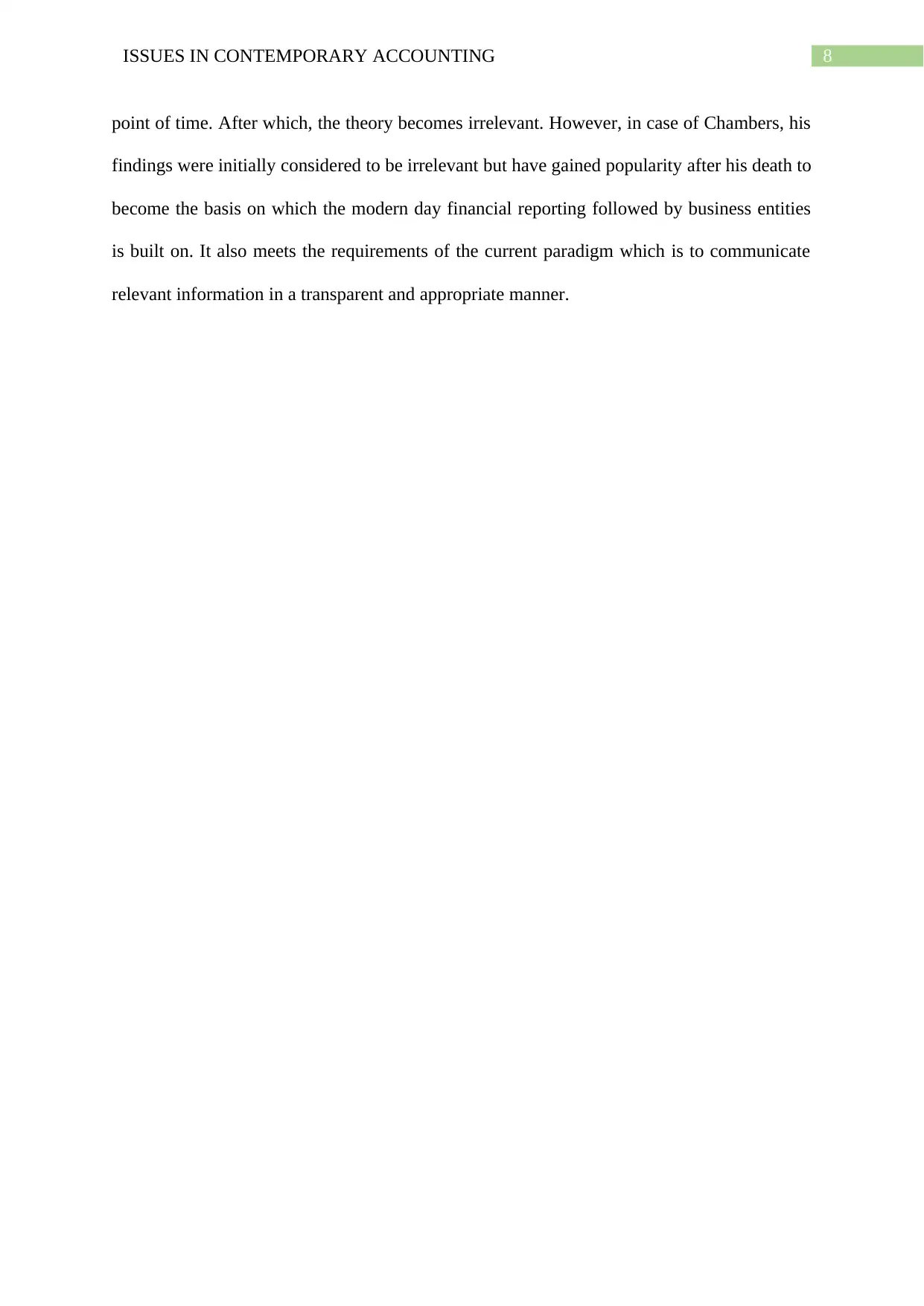
8ISSUES IN CONTEMPORARY ACCOUNTING
point of time. After which, the theory becomes irrelevant. However, in case of Chambers, his
findings were initially considered to be irrelevant but have gained popularity after his death to
become the basis on which the modern day financial reporting followed by business entities
is built on. It also meets the requirements of the current paradigm which is to communicate
relevant information in a transparent and appropriate manner.
point of time. After which, the theory becomes irrelevant. However, in case of Chambers, his
findings were initially considered to be irrelevant but have gained popularity after his death to
become the basis on which the modern day financial reporting followed by business entities
is built on. It also meets the requirements of the current paradigm which is to communicate
relevant information in a transparent and appropriate manner.
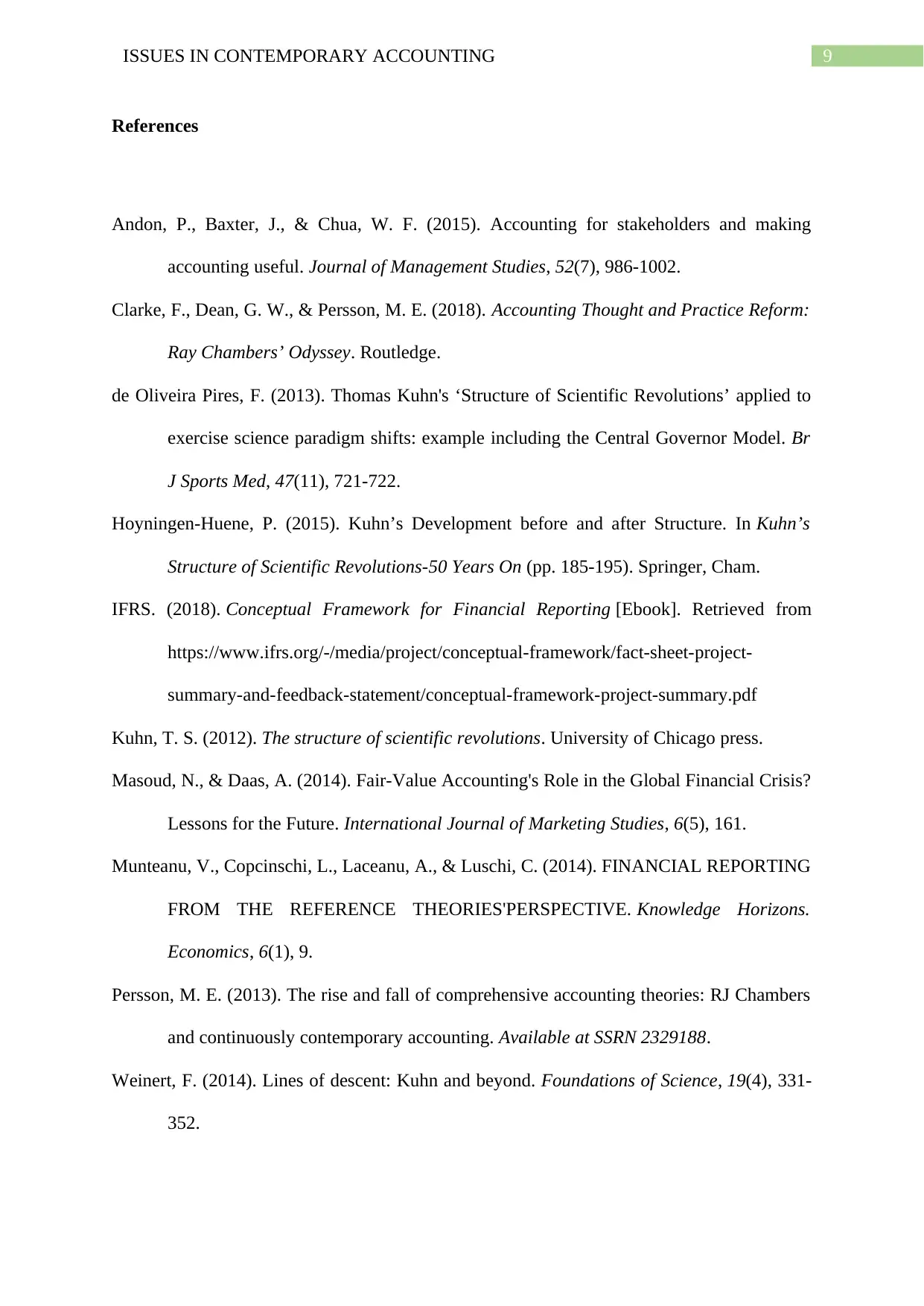
9ISSUES IN CONTEMPORARY ACCOUNTING
References
Andon, P., Baxter, J., & Chua, W. F. (2015). Accounting for stakeholders and making
accounting useful. Journal of Management Studies, 52(7), 986-1002.
Clarke, F., Dean, G. W., & Persson, M. E. (2018). Accounting Thought and Practice Reform:
Ray Chambers’ Odyssey. Routledge.
de Oliveira Pires, F. (2013). Thomas Kuhn's ‘Structure of Scientific Revolutions’ applied to
exercise science paradigm shifts: example including the Central Governor Model. Br
J Sports Med, 47(11), 721-722.
Hoyningen-Huene, P. (2015). Kuhn’s Development before and after Structure. In Kuhn’s
Structure of Scientific Revolutions-50 Years On (pp. 185-195). Springer, Cham.
IFRS. (2018). Conceptual Framework for Financial Reporting [Ebook]. Retrieved from
https://www.ifrs.org/-/media/project/conceptual-framework/fact-sheet-project-
summary-and-feedback-statement/conceptual-framework-project-summary.pdf
Kuhn, T. S. (2012). The structure of scientific revolutions. University of Chicago press.
Masoud, N., & Daas, A. (2014). Fair-Value Accounting's Role in the Global Financial Crisis?
Lessons for the Future. International Journal of Marketing Studies, 6(5), 161.
Munteanu, V., Copcinschi, L., Laceanu, A., & Luschi, C. (2014). FINANCIAL REPORTING
FROM THE REFERENCE THEORIES'PERSPECTIVE. Knowledge Horizons.
Economics, 6(1), 9.
Persson, M. E. (2013). The rise and fall of comprehensive accounting theories: RJ Chambers
and continuously contemporary accounting. Available at SSRN 2329188.
Weinert, F. (2014). Lines of descent: Kuhn and beyond. Foundations of Science, 19(4), 331-
352.
References
Andon, P., Baxter, J., & Chua, W. F. (2015). Accounting for stakeholders and making
accounting useful. Journal of Management Studies, 52(7), 986-1002.
Clarke, F., Dean, G. W., & Persson, M. E. (2018). Accounting Thought and Practice Reform:
Ray Chambers’ Odyssey. Routledge.
de Oliveira Pires, F. (2013). Thomas Kuhn's ‘Structure of Scientific Revolutions’ applied to
exercise science paradigm shifts: example including the Central Governor Model. Br
J Sports Med, 47(11), 721-722.
Hoyningen-Huene, P. (2015). Kuhn’s Development before and after Structure. In Kuhn’s
Structure of Scientific Revolutions-50 Years On (pp. 185-195). Springer, Cham.
IFRS. (2018). Conceptual Framework for Financial Reporting [Ebook]. Retrieved from
https://www.ifrs.org/-/media/project/conceptual-framework/fact-sheet-project-
summary-and-feedback-statement/conceptual-framework-project-summary.pdf
Kuhn, T. S. (2012). The structure of scientific revolutions. University of Chicago press.
Masoud, N., & Daas, A. (2014). Fair-Value Accounting's Role in the Global Financial Crisis?
Lessons for the Future. International Journal of Marketing Studies, 6(5), 161.
Munteanu, V., Copcinschi, L., Laceanu, A., & Luschi, C. (2014). FINANCIAL REPORTING
FROM THE REFERENCE THEORIES'PERSPECTIVE. Knowledge Horizons.
Economics, 6(1), 9.
Persson, M. E. (2013). The rise and fall of comprehensive accounting theories: RJ Chambers
and continuously contemporary accounting. Available at SSRN 2329188.
Weinert, F. (2014). Lines of descent: Kuhn and beyond. Foundations of Science, 19(4), 331-
352.
Secure Best Marks with AI Grader
Need help grading? Try our AI Grader for instant feedback on your assignments.

10ISSUES IN CONTEMPORARY ACCOUNTING
1 out of 11
Related Documents
Your All-in-One AI-Powered Toolkit for Academic Success.
+13062052269
info@desklib.com
Available 24*7 on WhatsApp / Email
![[object Object]](/_next/static/media/star-bottom.7253800d.svg)
Unlock your academic potential
© 2024 | Zucol Services PVT LTD | All rights reserved.





